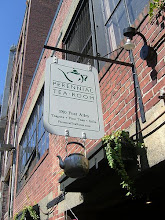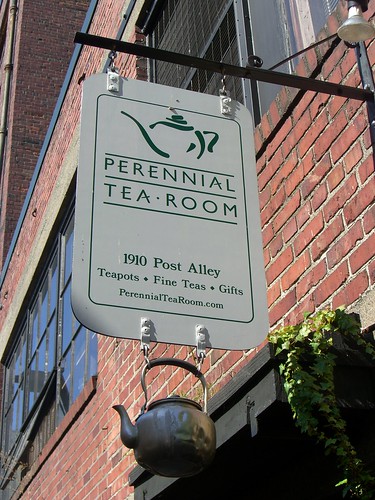Good Morning! Welcome to Tea Talk Friday. I need to start with a correction. I reversed the process on my arithmetic Wednesday and 11kilos would be closer to 22 pounds than 5. It is still a VERY pricey tea.
Anyway, on to Pu-Er (pu-erh) A category of it's own, like green, black or oolong. It has been produced in Yunnan from ancient times and shipped from the market town of Pu-Er until the tea acquired this name outside Yunnan. Pu-Er is a "made" tea, either green, black or white, which is sprayed with an unknown bacterium and allowed to undergo a sort of secondary fermentation. It may be compressed into many shapes or left loose and unique among teas, it improves with age.
In celebration of fall, and no other reason, we have a few (5) premium Pu-Er bricks. If you are interested in having one please let us know.
Thanks, as always, to the Tea Dictionary of James Norwood Pratt for the information on this unique tea. Published by Tea Society Press, San Francisco, 2010, printed in India.
See you Wednesday for Tea Talk Tuesday!
Julee
Friday, October 28, 2011
Wednesday, October 26, 2011
Tea Talk Tuesday - You won't believe this!
Hello - Tea Talk Tuesday is on Wednesday this week due to schedule changes at the tea shop.
This will happen again next week, then be back to regular blogging schedules. Thanks for your understanding.
So, I was speaking this morning with one of my tea vendors in England, ordering some of this year's Natela's Gold Standard, YUM!!! It will be here by next week! Watch for it!
Anyway, we were talking tea (of course) and he said that Harrods of London purchased the entire crop of Hawaiian tea for this year! It was not a large amount, only 11 kilos (which is about 5 pounds), but they did some fancy advertising and sold the entire amount in one day for $90,000.00 (approx). That comes out to $18,000.00 per pound, more or less! Pretty amazing!
It makes some of our more high priced teas seem pretty reasonable in contrast. I wonder what the difference is between this type of pricey tea and any other tea we could try?
See you Friday, for Tea Facts
Julee
This will happen again next week, then be back to regular blogging schedules. Thanks for your understanding.
So, I was speaking this morning with one of my tea vendors in England, ordering some of this year's Natela's Gold Standard, YUM!!! It will be here by next week! Watch for it!
Anyway, we were talking tea (of course) and he said that Harrods of London purchased the entire crop of Hawaiian tea for this year! It was not a large amount, only 11 kilos (which is about 5 pounds), but they did some fancy advertising and sold the entire amount in one day for $90,000.00 (approx). That comes out to $18,000.00 per pound, more or less! Pretty amazing!
It makes some of our more high priced teas seem pretty reasonable in contrast. I wonder what the difference is between this type of pricey tea and any other tea we could try?
See you Friday, for Tea Facts
Julee
Friday, October 21, 2011
Tea Fact Friday - Orthodox Manufacture
Good Morning - Happy Friday and welcome to Tea Fact Friday. Today I am going to discuss the facts of orthodox manufacture of tea. Orthodox Manufacture is the traditional method of tea manufacture by machines which mimic by-hand methods employed in old China. Each batch of leaf is withered and then put into rollers, which bruise and shape the tea prior to oxidation. Following oxidation "fermentation", the leaf is fired to arrest further chemical change and preserve it free of moisture. The tea is then graded by leaf size (op, bpoe,bopfp,etc). All of the world's great black teas are produced by orthodox manufacture, which preserves the integrity and full flavour of the leaf. It is expensive and time-consuming compared to CTC manufacture, but the taste and visual difference is apparent.
Remember our Da Hong Pao! Have a great weekend! See you on Tea Talk Tuesday!
Thanks to the Tea Dictionary by James Norwood Pratt for the information presented. Tea Society Press, San Francisco, Calif. 2010 Printed in India.
Remember our Da Hong Pao! Have a great weekend! See you on Tea Talk Tuesday!
Thanks to the Tea Dictionary by James Norwood Pratt for the information presented. Tea Society Press, San Francisco, Calif. 2010 Printed in India.
Tuesday, October 18, 2011
Tea Talk Tuesday - Da Hong Pao
Hello, Happy Tuesday! Another week to explore and develop! Today I am going to be very specific and talk about Da Hong Pao (Big Red Robe) oolong tea unique to Wu Yi Shan China and perhaps it's most celebrated and expensive Yancha (rock Tea). Clinging to Jiulongke Cliff in the Tianxinyan area of the Wuyi Mountains, the original three or four Da Hong Pao tea bushes still survive, with leaves slightly thicker than others' and slightly pinkish buds. In a canyon called Nine Dragons' Nest the sun shines directly only a few hours per day and a small stream from a nearby spring seeps through a slit in the rock into the sandy soil, creating an ideal place for tea growing. The ancient plants are centuries old and their offspring grow here and there in the canyon, though almost nowhere else. Commercial production of Da Hong Pao cultivars only began in the 1960s. What made this tea famous and inspired its name was a Ming Dynasty mandarin who attributed his recovery of illness to its curative powers and in thanks, draped his official's scarlet robe of high office over the bushes and repectfully kowtowed before them.
So, what a story! What a tea! I am talking about it specifically because I have received 11 ounces of it from a colleague and I would like to offer it to our customers. It is a very rare oolong and I will sell it by the ounce for $15.00/ounce. An ounce will start at least 14 -20 cups, the re-steeping times are up to you. Let me know, just phone the store 206 448-4054 if you would like some.
Thanks to the Tea Dictionary by James Norwood Pratt for the information about this fine tea.
Published by Tea Society Press, San Francisco, CA 2010, printed in India.
So, what a story! What a tea! I am talking about it specifically because I have received 11 ounces of it from a colleague and I would like to offer it to our customers. It is a very rare oolong and I will sell it by the ounce for $15.00/ounce. An ounce will start at least 14 -20 cups, the re-steeping times are up to you. Let me know, just phone the store 206 448-4054 if you would like some.
Thanks to the Tea Dictionary by James Norwood Pratt for the information about this fine tea.
Published by Tea Society Press, San Francisco, CA 2010, printed in India.
Friday, October 14, 2011
Tea Talk Friday - Russian Caravan
Good Morning and happy weekend approaching! Today I am going to talk about Russian Caravan Tea - historically, the most important drink after vodka in old Russia. During the time of the Czars, tea would travel by camel from China to Moscow. The tea was famous for the smoky smell of the campfire it would absorb along the journey. In 1689, Russia and China signed the Treaty of Nerchinsk establishing their common border and enabling regular camel caravans to transport tea via Mongolia. The caravans took a long and difficult overland route of over 6000 miles and lasted 6 months. The completion of the Trans-Siberian Railway in 1905 shortened the trip to mere weeks and sent the camel caravans into oblivion. It also changed the tea and today it is any black tea blend with a dash of Lapsang added.
Thanks to James Norwood Pratt's Tea Dictionary - Published by Tea Society Press, San Francisco 2010 - printed in India - for the information.
Thanks to James Norwood Pratt's Tea Dictionary - Published by Tea Society Press, San Francisco 2010 - printed in India - for the information.
Tuesday, October 11, 2011
Tea Talk Tuesday - Famous Name Teas
Hello again: It's been an intense week traveling with Mr. and Mrs. Pratt, but I am finally settling back into my regular fall routine. I thought today I would talk about some famous named teas, Earl Grey, Prince of Wales, Queen Anne and Queen Mary. Earl Grey is the West's most popular tea, most popular black tea, and most popular scented tea, in that order. Named after the 1830's Prime Minister it is traditionally any tea flavored with bergamot. Corfu was the center of bergamot trade during the time the British Meditererranean Fleet was headquartered there and commanded by Lord Grey from London, Bickering still continues between Twinings and Jacksons of Picadilly as to who rightfully has the original recipe. Prince of Wales is a proprietary blend created by Twinings for Edward VIII, the abdicator. Edward apparently granted Twinings permission to resell his personal blend using his royal title in 1921. Queen Anne is a popular tea blend created in 1907 by Fortnum & Mason to commemorate the reigning sovereign at the time company was established in 1707 (must have been a bicentenial). It is a blend of some of the best gardens of Assam and Ceylon producing a strong, smooth tea suitable for all day drinking. Queen Mary is another proprietary Twinings blend consisting of muscatel Darjeelings, and much beloved by the wife of George V.
WOW! That's a mouthful (of tea). Keep drinking and I will keep bloging. See you all at Tea Fact Friday. Thanks to James Norwood Pratt's Tea Dictionary, published by Tea Society Press, San Francisco, CA, printed in India, for the information provided.
Julee
WOW! That's a mouthful (of tea). Keep drinking and I will keep bloging. See you all at Tea Fact Friday. Thanks to James Norwood Pratt's Tea Dictionary, published by Tea Society Press, San Francisco, CA, printed in India, for the information provided.
Julee
Friday, October 7, 2011
Tea Fact Friday - Report on NW Tea Festival
Hello again, nice to be back. What an experience the Festival was! We received wonderful comments on the new location and the workshops and tastings were a terrific success. A few highlights for me were: the Tea Somalier class in which Norwood Pratt gave a history of tea followed by tasting all the varieties from white, yellow, green, darjeeling first and second flush, China black and pu-erh. The Chinese Tea Terms was well received as was the tea roasting class.
There are so many events that it is difficult to single many out - tea blending, cupping, gong-fu for children, and more. It was terrific. If you were not able to be there, mark your calendar for next year, October 6 - 7 at the Fisher Pavilion. A real treat.
See you Tuesday,
Julee
There are so many events that it is difficult to single many out - tea blending, cupping, gong-fu for children, and more. It was terrific. If you were not able to be there, mark your calendar for next year, October 6 - 7 at the Fisher Pavilion. A real treat.
See you Tuesday,
Julee
Subscribe to:
Posts (Atom)


